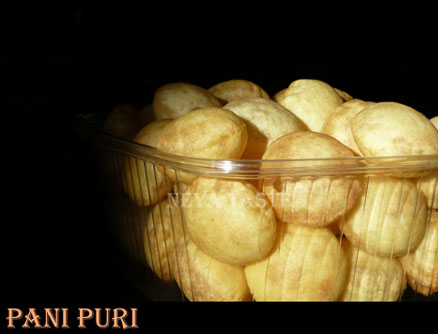|
Panipuri is a very popular street snack in the
Indian subcontinent. Itís a treat people love to eat
and enjoy anytime of the day or at night.
Panipuri originated from the Uttar Pardesh region of
India. It may have originated from Banares.
Panipuri (Hindi)
पानीपूरी,(Marathi)
पाणीपुरी,
term used in Western India, also known as Gol Gappa
(North India), Phuchka (Bengal), bataashaa or Gup
chup in Orissa and south India. Pani Puri is also a
delicacy in Nepal.
It comprises a round, hollow "puri", fried crisp and
filled with a watery mixture of tamarind, chilli,
chaat masala, potato, chopped onion and chickpeas.
Its size is small enough to fit in the mouth.
Panipuri is a hollow, puffed, round dough with a
crunchy shell. The shell by itself is tasty, and it
taste even better when it is filled with a spicy
potato-based mixture and dipped in masala water. The
stuffing is prepared separately, and inserted into
the panipuri through a hole made in the shell by a
thumb or a small spoon. It is then dipped in the
masala water and served.
It is the associated stuffing and recipe of the
masala water that makes it unique. The stuffing and
water recipes vary from region to region, and the
regional names vary also.
Traditionally, panipuris are eaten by placing the
entire puri into the mouth in one go and biting into
it. This releases a barrage of different tastes. You
can also enjoy it with curd and different types of
masalas and sev etc.
|









